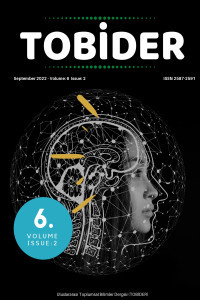TÜRK MÛSIKÎSİNDE KÂRÇE FORMU’NUN YAPISAL ÖZELLİKLERİ
Türk mûsıkîsi, Form, Kârçe
THE STRUCTURAL FEATURES OF KÂRÇE FORM IN THE TURKISH MUSIC
Turkish Music, Form, Kârçe,
___
- Ayangil, R. (2014). “XVII. Yüzyılda Türk Mûsikîsi”, Yeni Türkiye Dergisi, yıl 10, sayı 57, s. 474.
- Behar, C. (2010). Şeyhülislâmın Müziği. İstanbul: Yapı Kredi Kültür Sanat Yayıncılık.
- Ezgi, S. (1940). Nazarî ve Amelî Türk Mûsıkîsi, (c:3). İstanbul: İstanbul Belediye Konservatuvarı Neşriyatından.
- Darbaz, F. (1973). Temel Bilgilerle Beraber Tonâl-Modâl-Ölçü ve Biçim Bakımından Türk ve Batı Müziği, İstanbul: Musiki Kültür Derneği Yayınları: No.1
- Güntekin, M. (2014). “Osmanlı’da Mûsıkî ve “Hikmete Dâir Fenn’in” “Son Osmanlıları”, Yeni Türkiye Dergisi, yıl 10, sayı 57, s. 1238.
- Özalp, M. N. (1986). Türk Mûsıkîsi Tarihi (Cilt 1), Ankara: Milli Eğitim Bakanlığı yayınları.
- Özalp, M. N. (1992). Türk Mûsıkîsi Beste Formları, Ankara: TRT Genel Sekreterlik Basım ve Yayım müdürlüğü Yayınları. Özalp, M. N. (2000). Türk Mûsıkîsi Tarihi (c:1), İstanbul: Milli Eğitim Bakanlığı Yayınları.
- Öztuna, Y. (1969). Türk Bestecileri. İstanbul: Hayat Neşriyat Yayınları.
- Öztuna, Y. (1990). Büyük Türk Musikisi Ansiklopedisi, (c:1), İstanbul: Milli Eğitim Bakanlığı Devlet Kitapları Milli Eğitim Basımevi.
- Öztuna, Y. (2000). Türk Musikisi Kavram ve Terimleri Ansiklopedisi, Ankara: Atatürk Kültür Merkezi Yayını: 245.
- Tanrıkorur, C. (1998). Müzik Kimliğimiz Üzerine Düşünceler. İstanbul: Ötüken Yayınları.
- Tanrıkorur, C. (2011). Osmanlı Dönemi Türk Mûsıkîsi, İstanbul: Dergâh Yayınları.
- Ünsal, N. (1988). Türk Mûsikisinde Kâr Formu, Yayımlanmamış Yüksek Lisans Tezi), İstanbul Teknik Üniversitesi Sosyal Bilimler Enstitüsü, İstanbul.
- Yavaşça, A. (2002). Türk Mûsıkîsinde Kompozisyon ve Beste Biçimleri. İstanbul: Mart Matbaacılık.
- Yener, S. (2014). Türk Müziğinin Tarihi Gelişimi ve Müziksel Kimlik , “Osmanlı Döneminde Türk Müziği”, Yeni Türkiye Dergisi, yıl 10, sayı 57, s. 14.
- Başlangıç: 2017
- Yayıncı: Sadık Hacı
REKLAM VE TANITIM FOTOĞRAFÇILIĞININ TOPLUM ÜZERİNE OLAN ETKİSİ
PHOTOGRAPHY'S DEVELOPMENT OF ARCHITECTURE
BAŞLANGIÇTAN GÜNÜMÜZE BULGAR ÖYKÜ SANATI
TÜRK MÛSIKÎSİNDE KÂRÇE FORMU’NUN YAPISAL ÖZELLİKLERİ
BİR SOSYALİST REALİSTİN DOĞUŞU: MAKSİM GORKİ ROMANTİZMİ
Emine ÖZTÜRK, Mürüvvet Özlem PARER
BULGAR MİTOLOJİSİ ÜZERİNE BİR İNCELEME
J.G. BALLARD’IN THE CRYSTAL WORLD ROMANINDA TOPRAK ETİĞİ VE İNSANMERKEZCİLİK
TÜRK MÜZİĞİ DİNLEME KÜLTÜRÜNÜN, GÜNÜMÜZ Z KUŞAĞI NESLİNE AKTARILMASINA DAİR BİR ÖNERİ
